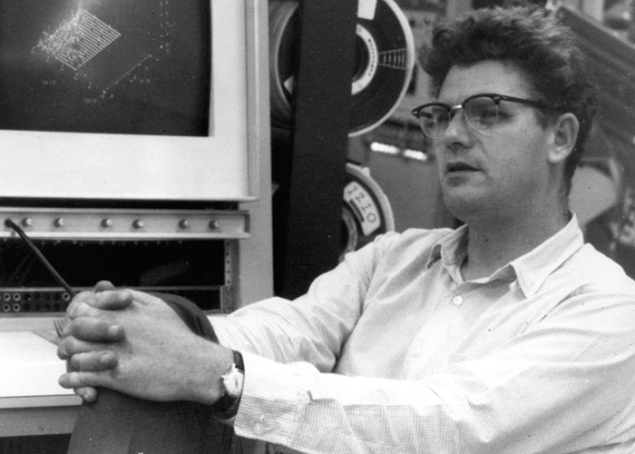
Richard E Taylor died at the age of 88 on 22 February at his home on the Stanford campus in the US. Taylor was the co-recipient of the 1990 Nobel Prize in Physics, along with Henry Kendall and Jerome Friedman of MIT, for their discoveries of scaling in deep-inelastic electron–proton scattering. It was these results that led to the experimental demonstration of the existence of quarks.
Taylor was born in Medicine Hat, Alberta, Canada, to Clarence and Delia Taylor. He was interested in a career as a surgeon, but an early explosion while using a chemistry set as a child cost him parts of two fingers and the thumb on his left hand – and thus pushed him towards a career in science. He was an undergraduate at the University of Alberta, receiving a bachelor and then master of science in 1952. At Alberta, he married Rita Bonneau in 1951.
Taylor then went to Stanford, working at the Stanford High Energy Physics Laboratory (HEPL). In 1958, he was invited by colleagues at École Normale Supérieure in Orsay to work on experiments for their new accelerator at the Laboratoire de l’Accelerateur Lineare. After three years, he returned to the US, spending a year at Lawrence Berkeley National Laboratory. He then returned to Stanford to complete his PhD under Robert Mosely in 1962. Wolfgang Panofsky invited him to join the core group building the Stanford Linear Accelerator Center (SLAC), roughly 1 km west of the main Stanford campus. Taylor was given responsibility for the “Beam Switchyard” at the end of the linear accelerator that analysed and steered beams to experiments and for the large “End Station A” and its electron spectrometers. Taylor organised a talented group at SLAC including David Coward and Herbert (Hobie) DeStaebler, which carried out the design and construction of these major facilities. The three electron spectrometers with momentum ranges centered around 1.6, 8 and 20 GeV/c made the critical measurements that established SLAC in the forefront of particle physics.
Taylor led his group at SLAC into a collaboration with Caltech and MIT that foresaw the rise of powerful particle-physics collaborations now at the scale of a few thousand physicists for the major LHC experiments. That collaboration proposed and carried out a series of experiments beginning with the elastic scattering of electrons off protons at high momentum transfer in 1967. The measurements extended those made by Richard Hofstadter at HEPL, but led to no surprises.
The proposal for deep-inelastic scattering had no mention of point-like particles in the nucleon. The inelastic cross sections beyond the nucleon resonances were unexpectedly large and flat with increasing momentum transfer, especially when compared to elastic scattering. The data also displayed a simplifying feature called scaling – a prediction by Bjorken from current algebra – suggesting that deep-inelastic cross sections could be expressed as a function of one kinematic variable. These results were extended by Taylor’s group and MIT into more kinematic regions and to studies of the neutron with a deuterium target.
At the “Rochester Conference” in Vienna in 1968, Panofsky summed up the first public results of the experiments with the comment: “Therefore, theoretical speculations are focused on the possibility that these data might give evidence on the behaviour of point-like, charged structures within the nucleon.” Following a visit to SLAC in August 1968, Richard Feynman introduced his “naïve parton theory” in which electrons scattered from point-like free partons give both the observed weak momentum-transfer dependence and scaling. Subsequent experiments by Taylor and collaborators allowed the two nucleon structure functions to be separated, determining that the partons were spin-½ particles. Evaluations of sum rules derived by Bjorken and Kurt Gottfried were consistent with charge assignments in the nascent quark model. Finally, the Gargamelle neutrino and antineutrino results at CERN confirmed the Gell–Mann–Zweig quark model, and these experiments collectively gave rise to the Standard Model of particle physics.
Taylor’s connections to Paris, and later DESY and CERN, continued as a theme through his life. He was awarded a doctorate (Honoris Causa) by the Université de Paris-Sud. After becoming a member of the SLAC faculty in 1968, Taylor won a Guggenheim fellowship and spent a sabbatical year at CERN. He received an Alexander von Humboldt award and spent the 1981–1982 academic year at DESY. Taylor’s group at SLAC was a lively place, with many young European visitors who became staunch colleagues and friends.
In 1978, an experiment at SLAC led by Charles Prescott and Taylor demonstrated parity violation in polarised electron–deuterium scattering – a very challenging experiment that followed negative results from atomic-physics experiments. Parity violation was the essential component of the unification of the electromagnetic and weak interactions, another key chunk of the Standard Model that led to the Nobel Prize for Sheldon Glashow, Abdus Salam and Steven Weinberg in 1979.
Taylor also was awarded the W K H Panofsky Prize, and was a fellow of the American Physical Society, American Association for the Advancement of Science, Royal Society and the Royal Society of Canada. He was also a member of the American Academy of Arts and Sciences and the Canadian Association of Physics, a foreign associate of the National Academy of Science, and Companion of the Order of Canada.
Taylor stayed rooted to his Canadian origins, often vacationing in Medicine Hat where he maintained a home and enjoyed fly fishing in the local streams. He always saw himself as an experimentalist, saying in a 2008 Nobel-prize interview: “My job was to measure things and to make sure that the measurements were right. It is the job of the theoretical community to understand why things are the way that I see them when I do experiments.”
Taylor was a large man and pretended to enjoy a reputation of being somewhat fierce. His friends and colleagues all knew him as a gentle soul, caring deeply for SLAC and always promoting the younger generations of scientists. He is survived by his wife Rita and son Ted.








